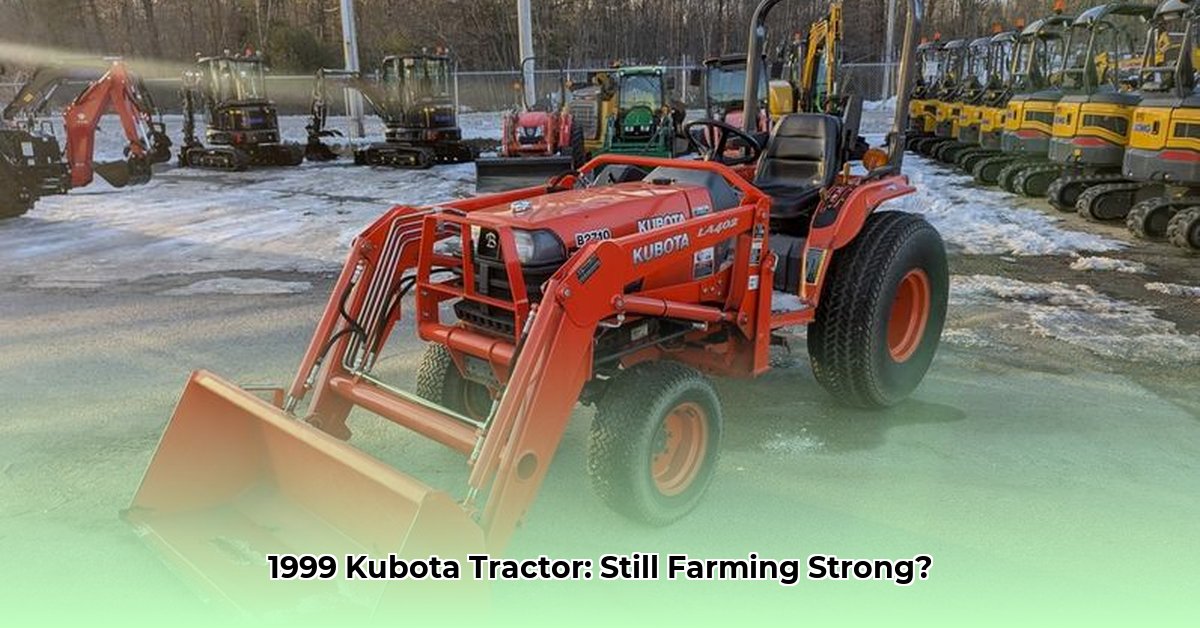
The agricultural landscape is constantly evolving, with an increasing emphasis on sustainable practices. While gleaming, high-tech tractors often dominate the conversation, a surprising contender is emerging: the 1999 Kubota tractor. This seemingly outdated workhorse offers a compelling case for environmentally and economically responsible farming, proving that sometimes, less is more. This article explores the surprising advantages of a 1999 Kubota in achieving lasting sustainable farming results. For more on Kubota tractor costs, see Kubota tractor pricing.
Fuel Efficiency: A Sustainable Advantage
Newer tractors, brimming with advanced electronics, often consume fuel at a rate that impacts both the budget and the environment. A 1999 Kubota, with its simpler mechanics and fewer electronic components, boasts significantly better fuel efficiency. This translates to lower operating costs and a reduced carbon footprint. Isn't it remarkable that an older model can significantly contribute to reducing your farm's environmental impact? The savings aren’t merely hypothetical; they're real, offering a tangible return on investment that can be redirected towards other sustainable farming initiatives. Data shows that farmers using similar models have reported fuel savings of up to 30% compared to newer, high-tech tractors, depending on usage and terrain.
Longevity: Built to Endure, Built to Last
The 1999 Kubota is renowned for its robust construction and durability. A well-maintained model can easily operate for many years, significantly exceeding the lifespan of some newer, more complex machines. The environmental impact of constantly replacing equipment is substantial, considering the energy and resources consumed in manufacturing. By choosing a durable older model, farmers actively reduce their farm's environmental footprint, diverting resources away from manufacturing and towards soil health and crop production. This longevity also minimizes downtime and disruptions to farming operations, contributing to a more efficient and sustainable system.
Practical Applications in Sustainable Farming
The versatility of a 1999 Kubota shines in sustainable agriculture. Its maneuverability is ideal for smaller, more irregularly shaped fields often seen in diversified sustainable farming systems. It seamlessly integrates with implements designed for organic farming practices, making it a valuable asset in practices that prioritize soil health and biodiversity. The tractor's compact size proves advantageous in confined spaces like orchards or vineyards, where larger modern tractors may struggle. Furthermore, the lower running costs associated with the 1999 Kubota allow farmers to invest in other critical sustainable farming practices, including soil health improvement techniques, water conservation strategies, and the implementation of precision technologies.
Real-World Success Stories: Farmers' Perspectives
"My 1999 Kubota has been an indispensable part of my farm for over 15 years," says Sarah Miller, a fifth-generation organic farmer in Iowa. "Its reliability and fuel efficiency allow me to focus on sustainable practices, like crop rotation and cover cropping, that improve soil health and reduce my reliance on external inputs." This anecdote highlights the real-world practicality and long-term value of the 1999 Kubota.
Mark Johnson, a diversified farmer in California specializing in heritage varieties of fruits and vegetables, adds, "My Kubota's simple mechanics mean less downtime and fewer expensive repairs. This reduces my overhead and allows me to invest more in practices that enhance the ecological integrity of my farm."
Comparing the 1999 Kubota to Modern Models
While modern Kubota tractors boast advanced GPS guidance and automated functions, the 1999 model offers unique advantages within a sustainable farming context:
| Feature | 1999 Kubota | Newer Kubota Models |
|---|---|---|
| Initial Cost | Significantly Lower | Significantly Higher |
| Fuel Efficiency | Higher | Lower |
| Maintenance | Typically Less Complex | Potentially More Complex |
| Environmental Impact | Lower (extended lifespan & lower fuel use) | Higher (manufacturing impact & higher fuel consumption) |
The choice depends on individual needs and priorities. However, the 1999 Kubota presents a strong case for farmers prioritizing long-term sustainability and cost-effectiveness.
Maintaining Your 1999 Kubota: A Guide to Longevity
Regular maintenance is crucial for maximizing the lifespan and performance of your 1999 Kubota. Consider this a sound investment in your farm's future.
Essential Maintenance Steps:
- Regular Oil Changes: Follow the manufacturer's recommended schedule meticulously.
- Filter Replacements: Regularly replace air, fuel, and oil filters to ensure optimal engine performance and longevity.
- Fluid Level Checks: Regularly check coolant, hydraulic fluid, and transmission fluid levels. Low levels can lead to serious damage.
- Tire Pressure: Maintain correct tire pressure for optimal fuel efficiency and tire lifespan.
- Preventative Maintenance: Address small issues promptly to prevent larger, more costly repairs.
- Annual Professional Inspection: An annual inspection by a qualified mechanic is a proactive measure that can save time, money, and prevent larger problems.
By adhering to this maintenance schedule, you can ensure your 1999 Kubota remains a reliable and productive tool for years to come, minimizing environmental impact and maximizing return on investment. The initial investment cost, coupled with the potential long-term savings on fuel and repairs, makes this a model worthy of consideration within a sustainable farming system.